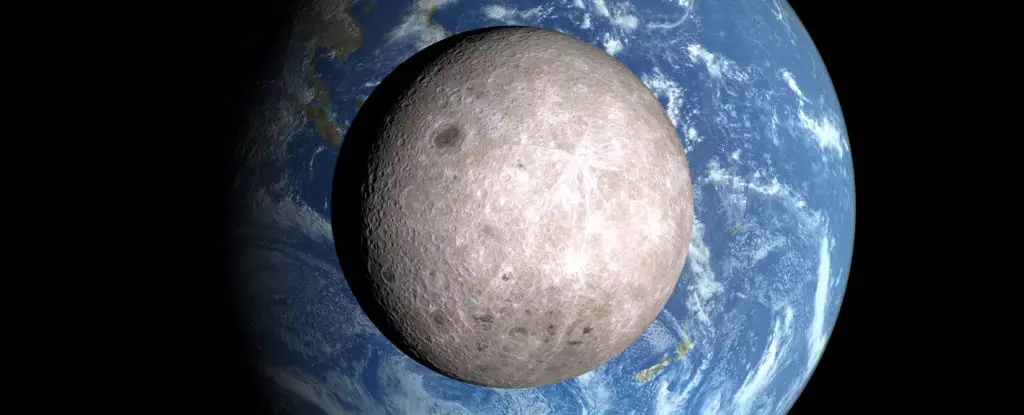The Moon, humanity’s celestial companion, has long fascinated scientists and enthusiasts alike. Recent analyses of lunar materials have revealed a puzzling aspect of our natural satellite: an uneven distribution of water. The far side of the Moon, which perpetually turns its back on Earth, has significantly less water than the side we can see. This intriguing discrepancy holds the potential to unravel deeper mysteries about the Moon’s formation and evolution. It raises questions about how the chemical compositions of both lunar hemispheres influence their geological characteristics, revealing a story of cosmic events that may forever change our understanding of the Moon’s history.
Geological Contrasts: Heavily Cratered Far Side vs. Basaltic Maria
The surface of the Moon is a testament to its tumultuous past. The far side, defined by its heavily cratered landscape, starkly contrasts with the near side, which showcases expansive basaltic plains, also known as maria, created from ancient volcanic activities. These stark visual and geological differences prompt contemplation over their implications. Scientists propose that these disparities stem from variations in the Moon’s interior composition—a theory that could elucidate the Moon’s unique appearance.
Recognizing the importance of water in the lunar mantle, researchers from the Chinese Academy of Sciences have emphasized its role not only in volcanic activities but also in the models detailing the Moon’s giant impact formation. Their findings suggest that understanding how water is distributed within the Moon can lead to insights about the violent celestial collision that birthed it, while also influencing subsequent geological processes and volcanic activity.
The Giant Impact Hypothesis: Forming the Moon
The prevailing theory regarding the Moon’s origin stems from a catastrophic collision between the early Earth and a Mars-sized celestial body, Theia, some 4.5 billion years ago. As debris from this collusion coalesced in Earth’s orbit, the Moon was formed. Initially composed primarily of magma, the Moon underwent significant geological evolution, most notably characterized by the creation of the lunar maria on the near side between 3.9 and 3.1 billion years ago. This process, however, did not occur uniformly across its surface—a phenomena reflected in the mineral deposit variances, leading to scientific curiosity over the relationship between the impact event and the consequential lunar features.
It’s this relationship that particularly intrigues researchers. The differences in the Moon’s crustal thickness—thinner on the far side—might stem from heat retention from Earth, influencing cooling rates after the planet’s formation. Such cooling is an essential variable in understanding why the near side boasts more basalt formations.
Insights from Chang’e-6: The First Far Side Samples
China’s Chang’e-6 mission has proven pivotal in advancing our knowledge of lunar geology. By successfully returning samples from the far side of the Moon, scientists now possess tangible materials to analyze the Moon’s chemical makeup. The analyses performed by a team led by Huicun He and Linxi Li revealed evidence of minimal water content in the basalt sourced from the South Pole-Aitken Basin, one of the biggest impact craters on the far side. Their findings indicated a mere 1 to 1.5 micrograms of water per gram—significantly lower than what is generally found on the near side.
This assessment ignites a compelling discussion about the implications of such findings. Could the violent collision that created the South Pole-Aitken Basin have redistributed water from the far side, favoring the near side instead? While scientists aim to gather more samples to enhance their understanding, this single sample underscores the suggested trend of hydrous disparity between the Moon’s hemispheres, hinting at a far more complex geological narrative than previously assumed.
The Future of Lunar Research: Quest for More Knowledge
As researchers continue to probe the Moon’s depths, the urgency for future missions becomes evident. These missions could dramatically expand our understanding of the lunar crust’s chemical compositions and hydration levels, casting further light on the past impacts that shaped our celestial neighbor. Future explorations could help establish whether the scarcity of water on the far side extends throughout its interior or if other regions harbor greater reserves.
The question remains: how will these scientific endeavors impact our comprehension of lunar evolution and, by extension, planetary formation in the solar system? Understanding the Moon’s water distribution has implications that stretch beyond its surface, offering clues about not just our lunar companion, but other celestial bodies in the cosmos. In this ongoing quest for lunar knowledge, every sample collected could unlock a piece of the vast puzzle that is our universe, highlighting the significance of exploring beyond our terrestrial home.


Leave a Reply